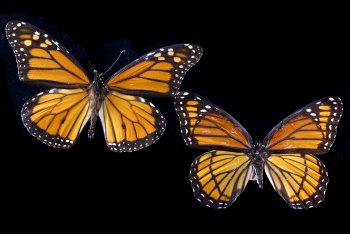Monarch Butterfly (Danaus plexippus)
The colorful Monarch butterfly, the State Insect of Illinois, is widely distributed across eastern and central North America down to Mexico and along the west coast of the United States. Its caterpillars feed exclusively on milkweeds (Asclepias sp.), and the milky sap in the plant leaves gives Monarch caterpillars and adults a bitter taste. The bright colors of the adults and caterpillars serve as a warning to potential predators.
The Viceroy butterfly (Limenitis archippus) has evolved to mimic the appearance of the Monarch. These butterflies are also bad-tasting, and the shared color pattern benefits both species; predators only have to learn once, and they avoid orange and black. The picture shows the Monarch (left) and Viceroy together for comparison. Note the additional black band on the Viceroy's hind wing and the more scalloped appearance of the edges of the wings, making it easy to tell the two apart.
Monarchs are long-distance travelers with a unique migratory life cycle that requires multiple generations to complete. Each year, the last generation of monarchs in late summer/early fall migrates to Mexico where they overwinter in huge colonies. Monarch numbers have been dropping since the 1990s due to land use changes and increased use of pesticides. States in the central United States are working together on conservation efforts to boost habitat, and hopefully numbers, of the charismatic insect.
It's also interesting to note, if you look closely at the second image, you can tell the male from the female of the species by the small scent gland on the hind wing of the male (black spot at bottom right).






